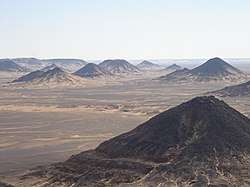Black Desert (Egypt)
The Black Desert (Arabic: الصحراء السوداء, aṣ-Ṣaḥrāʾ as-sawdāʾ) is a region of volcano-shaped and widely spaced mounds, distributed along about 30 km in western Egypt between the White Desert in the south and the Bahariya Oasis in the north. Most of its mounds are capped by basalt sills, giving them the characteristic black color.[1]
Black Desert الصحراء السوداء | |
|---|---|
 Volcano-shaped mounds of the Black Desert | |
| Coordinates: 28.150711°N 28.728561°E | |
| Country | Egypt |
| Dimensions | |
| • Length | 30 km (20 mi) |
| Elevation | 100 m (300 ft) |
Geology
The mounds of the Black Desert, up to 100 m high, vary in size, composition, height, and shape as some are dark consisting of iron quartzite while others are more reddish as its surface rocks consist of iron sandstone. On the outskirts of the Black Desert are volcanic hills proving the eruption of dark volcanic dolerite, dating back to the Jurassic period 180 million years ago.[2]
Palaeobiology
Remains of shrubs, and fossilized woodlands have been found in the Black Desert indicating that it once has worn a dress of greenery and freshness.[3]
Declaration of Natural Reserve
After discovering a large dinosaur skeleton on its borders, the Black Desert has been declared a natural reserve as of 2010.[4]
References
- Ekaterina E. Plyusninaa, Emad S. Sallamb, Dmitry A. Rubana; Geological heritage of the Bahariya and Farafra oases, the central Western Desert of Egypt, Journal of African Earth Sciences (2016).
- A.M. Afify, M.E. Sanz-Montero, J.P. Clavo, H.A. Wanas; Diagenetic origin of ironstone crusts in the Lower Cenomanian Bahariya Formation, Bahariya Depression, Western Desert, Egypt. Journal of African Earth Sciences 2015, vol. 101, pp. 333-349.
- The Black Desert Retrieved 2020/04/20.
- Egypt’s western desert: Retrieved 2020/04/20.